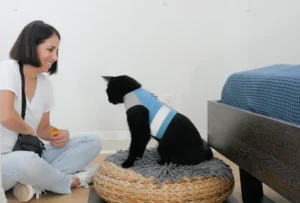The truth is that training cats may be just as enjoyable as training dogs! Teaching your cat a few important vocabulary terms and building a connection with her is possible through cat training near me.
Table of Contents
Introduction
Educating your cat to link a desired behavior with an item of value is known as cat training. You can both lead happier, healthier lives if you help them quit acting badly and start acting in the way you want them to.
Find it

Throw expensive candies to your cat’s paws; as soon as they can follow the throw, add the word “Find It.” Yes, that’s how easy it is. Then you may use your hands, or even Tupperware containers, to play the shell game. Use a dab of cat paste to promote licking and say “gentle” if she attempts to bite or claw your hand. When she softly taps or licks your hand, reveal the treat.
Sit

Click whenever your cat settles down on her own and give her a treat. Your cat scratching board will soon start to sit to greet you when you take out the treats. Once you can predict how she will behave, add the word “sit”. Next, attempt to draw her towards you by using a pointing gesture or target wand. Click to acknowledge this position. Use the clicker and snacks sporadically, and gradually stop clicking on each correct response. A more effective method of teaching is through intermittent rewards; if the kitty is always on the lookout for a reward, she will be more inclined to comply.
Gentle

Teach your kitties to view their hands as consistently fulfilling. Use a small amount of store-bought or homemade treat paste on your knuckles or the back of your hand to deter biting. If your cat or kitten starts to nibble or nip at your hand, gently remove it and say “gentle” to her.
Target

The tip of your finger works just as well as a homemade or store-bought target wand. Arrange the target so that it is two inches in front of your cat’s nose to teach it to be vigilant. Click and give her a prize as soon as she touches it. Saying the word “target” will cue your cat to move to the target once they do so consistently.
Come

Cats may pick up on coming the moment they step into your house. Combine the phrase “come” with pleasant memories and the shaking of a treat cup. To achieve this, place goodies in a cup or other container, shake it, and reward your cat each time it detects the sound. When your cat arrives, click and give her a treat. Shake the treats and say “come” more often as you go until she responds on cue. Reward her sporadically and gradually stop using the clicker.
On Your Mat & Stay

Spread a towel, cloth serviette, or flat mat on the counter, couch, or table to make a cat mat. Your cat may not perish from curiosity, but she will succumb to it! Click, when her foot hits the mat. Next, toss a treat just a little bit farther from the mat, making your cat come back for another go. Introduce progressively using the cue “on your mat.” Introduce the “stay” cue once your cat voluntarily goes to her mat and stays there. To get your cat to stay somewhere, like her cat tree, while you eat or prepare, use the mat. To comfort your cat during examinations at the vet or while on vacation, you may also bring your cat mat.
Cat Training Don’ts
Cats don’t take discipline well or learn from it. Although your cat may cease performing a certain behavior around you by swatting, spraying, or scaring, the behavior itself will not be stopped. Simply being there will kill any buzz and make the cat skeptical of your togetherness and distrustful of you. An attack with teeth and claws may also be sparked by physical discipline, and if aggressive behaviors are ingrained, they are hard to break. It is for this reason that educating your pet through positive reinforcement is crucial.
In the Box (or Cat Carrier)

Most cats will leap contentedly into a box or investigate a sack. When the time comes to take out the cat carrier, having a guideline for this behavior is helpful. Bring out the cat carrier well in advance of any need for it; you may even use it to feed your cat or kitten some of her meal and hide treats within. Click to reinforce your cat’s behavior when it leaps into a box or the carrier. As your feline asks, incorporate the cue “in the box.” Increasingly, move her around in her box or carrier while giving her a treat at the end of each ride.
Note: There might be affiliate links mentioned here. We may receive a commission if you purchase a product through an affiliate link. There is no additional charge for you. Please do your own research before making any online purchases.
What to know before you start cat training
Find the best time

Training sessions should be incorporated into your cat’s routine, which consists of feeding, sleeping, cat grooming services, and hunting. If you can, try training your cat as soon as they get out of bed in the morning. They’ll be more attentive and eager to play.
Keep training sessions brief

Cats’ attention spans are short. Less than fifteen minutes might be used for training sessions that are both productive and maintain your cat’s attention span. Recall that growth, not perfection, is the ultimate goal!
Eliminate distractions

Focus is impossible for a distracted cat. To conduct your training, choose a peaceful area away from family members and pets. Any ambient sound can confuse your cat and ruin your training session.
Stock up on treats

Cats require incentives, to begin with. Cats, in contrast to dogs, are less likely to be enthusiastic and willing to learn unless the rewards are worthwhile. Stock up on their favorite treats and delectable cat food to get the most out of your training sessions.
Common cat training methods
- Hand signals

One more excellent method for training your cat is to use hand gestures. Understanding which hand movements correspond with which orders is crucial. To enhance a behavior, you can do things like make a fist when you want your cat to sit or an open palm when you want a high five.
- Clicker training

One of the best techniques for training cats is clicker training. All you need is a tool—your tongue, a pen, or even a training clicker—that produces a soft clicking sound! The idea is to start a cycle of reinforcement by teaching your cat to identify the clicking sound with a reward. Later, you can teach them a new skill or desirable behavior that can also be associated with the click.
- Voice cues

Voice cues are expressions of specific words used to denote directives. Just like with hand signals, the idea is to link a word to an action and give your cat a reward when it’s completed. Saying their name or instructing them to sit down, for instance, will cause them to approach you.
Conclusion
Behavioral problems such as aggression or anxiety can still occur in cats that have received expert training. Unlike many insurance plans available, Pumpkin plans to assist pay for qualified veterinary expenditures for behavioral concerns because we understand how upsetting this may be for both you and your cat.












